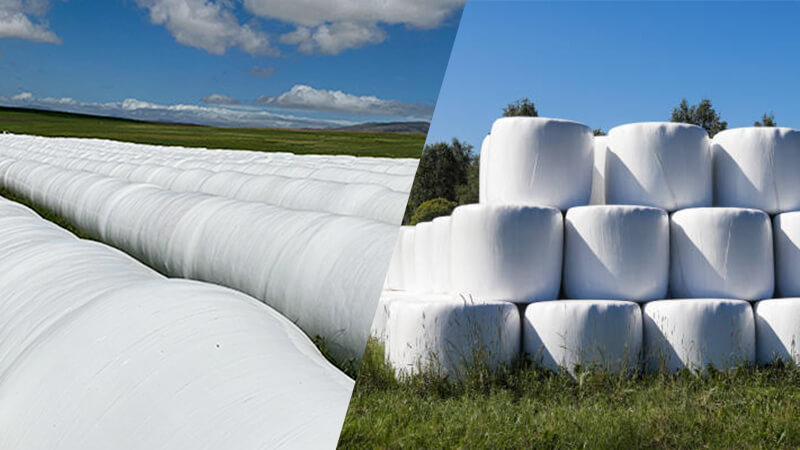Tube wrapping vs. individual wrapping: which is the best for silage bales?
Silage bales are a popular feed option for many livestock farmers/ranchers, but the way in which it is wrapped can make a big difference in quality and efficiency. Two popular methods for wrapping silage bales are tube wrapping and single bale wrapping (also called individual or one-at-a-time wrapping), each with its own pros and cons. While tube wrapping can save time and plastic waste, single-bale wrapping can offer more flexibility. In this article, we’ll take a closer look at the differences between these two methods and help you decide which one may be best for your farm or ranch.

A tube wrapper wraps silage bales in a continuous tube of plastic, while a bale wrapper wraps each bale separately in plastic. The main difference between the two is the way in which the plastic is applied to the bales. With a tube wrapper, the bales are placed inside a tube of plastic and then the tube is sealed, creating an airtight environment that helps to preserve the silage. With a bale wrapper, each bale is wrapped separately in plastic, which can be less efficient and time-consuming. Additionally, tube wrapping can have better preservation results because it creates a more sealed environment.
Where is tube wrapping used around the world?
Tube wrapping is a popular method for wrapping silage bales in many countries around the world, particularly in areas where silage is a commonly-used feed for livestock. Some examples of countries where tube wrapping is particularly popular include:
-
United States: In the US, tube wrapping is a common method of wrapping silage bales and is used by farmers and ranchers across the country.
-
Canada: Tube wrapping is also popular in Canada, particularly in the prairie provinces where silage is a commonly-used feed for cattle.
-
Europe: Tube wrapping is less used but not uncommon in many European countries, including the UK, Ireland, Germany, and France.
-
Australia and New Zealand: The method is also widely used in Australia and New Zealand, where it is seen as an efficient way of preserving silage for livestock.
It is worth noting that the popularity of tube wrapping may vary depending on the specific region and the type of livestock that are raised there. However, overall it’s a widely used method for preserving silage, but less than single bale wrapping mostly due to the cost of the equipment and the lack of flexibility for transport and storage.
The Pros and Cons of tube wrapping vs single bale wrapping for silage
| Pros | Cons | |
| Tube wrapping |
|
|
| Single bale wrapping |
|
|
Farmers’ opinions on tube wrapping versus single-bale wrapping
“As a dairy farmer, I’ve found that tube wrapping my silage bales has been a game changer for me. The efficiency of the process is incredible – I can wrap hundreds of bales in a matter of hours, and the preservation is unbeatable. I also appreciate the fact that I’m using less plastic overall, since I don’t have to individually wrap each bale. Overall, tube wrapping has been a huge time-saver and has allowed me to focus more on the day-to-day operations of my farm.”
Source: “Silage Production Part 4: The Best Way to Wrap Silage,” Progressive Dairy, August 13, 2019.
“I’ve always preferred to wrap my silage bales individually, since it allows me to have more control over the process. I can inspect each bale as it’s being wrapped, and make sure there aren’t any air pockets or other issues. I also appreciate the flexibility that individual wrapping provides – I can choose to wrap some bales in one type of plastic and others in a different type, depending on my needs. Plus, I find that it’s easier to move and stack the individual-wrapped bales, which is a big advantage when it comes to storage and transport.”
Source: “Tips for Silage Success,” Farmers Weekly, October 17, 2019.
In conclusion, the choice between tube wrapping and single bale wrapping ultimately comes down to the specific needs and resources of the farmer or rancher. While tube wrapping offers more efficiency and better preservation, it requires larger equipment and can be more expensive. single bale wrapping, on the other hand, provides more flexibility but can be more labour-intensive and less environmentally friendly. Regardless of which method you choose, it’s important to prioritize the quality and preservation of your silage to ensure the best possible feed for your livestock. We hope this article has helped you to better understand the differences between tube wrapping and single-bale wrapping and to make an informed decision for your farm or ranch.
And if you were wondering how to load a Hustler feedout wagon with tube-wrapped silage bales, watch the video below!
Here at Hustler, farming sustainably is at the heart of everything we do.
Our belief in sustainable farming practices underpins our range of world-leading livestock feeding solutions. If you are looking for farming equipment near you or buying livestock feeding equipment, contact our friendly team today!



























